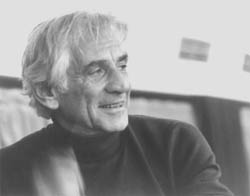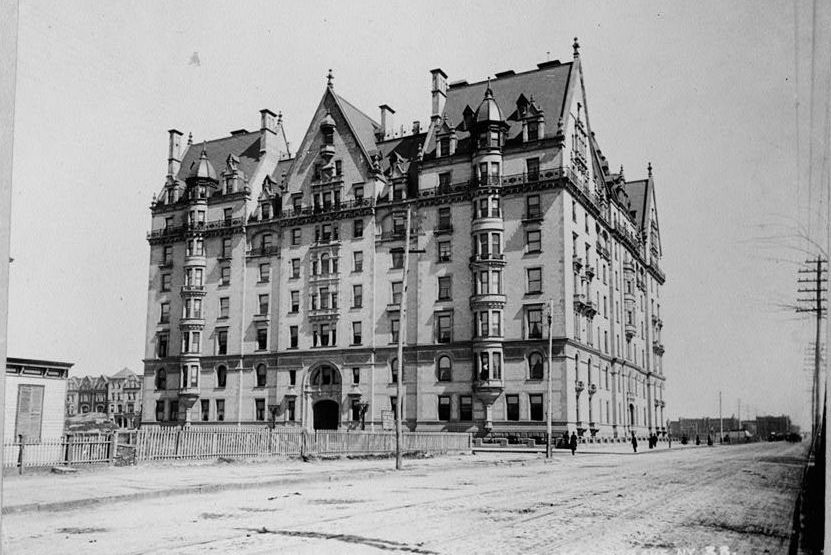

Leonard Bernstein: The Total Musician
A Personal Remembrance
by Jeffrey Dane
(Page 4)
The Dakota
(The Dakota in late 1880s or early 1890s)
The landmark building erected on Manhattan's Central Park West between 72nd & 73rd Streets in the 1880s was soon afterward dubbed the Dakota because of its then-isolated location. Featured in several films (including ROSEMARY'S BABY), it's been home to Boris Karloff (a fitting tennant, given the structure's Gothic atmosphere), Truman Capote, and John Lennon, who was murdered outside the entrance. Lauren Bacall, widow of Humphrey Bogart, resides there even now.
On the next block, between 71st & 72nd Streets, during the early years of this century, stood the Hotel Majestic. Almost prophetically, it was there that an upper-floor suite was occupied by Gustav Mahler during his first season in New York. The suite in which he lived with Alma and their daugther overlooked Central Park. (Mahler's aerial view of a fireman's funeral prompted the ominous bass drum strokes in the last movement of the uncompleted tenth symphony). It seems providential that a geographical proximity exists between Mahler and the man who was destined to become his most exponential interpreter in the last half of the 20th century, Leonard Bernstein. He was born seven years after Mahler died, but he spent the last 16 years of his own life living in the Dakota -- in a 2nd-floor apartment overlooking Central Park.
In mid-March, 1993, I received an invitation to an April 19th recital, "Bernstein -- Broadway and Beyond," at the Society for Ethical Culture on Manhattan's West 64th Street. The pianist would be Christopher Drobny, the vocal soloist Louise Edeiken, a young singer who, at the composer's own request, had premiéred Bernstein's song cycle, Arias and Barcarolles. The performance was sponsored by the BETA fund (Bernstein Education Through the Arts), an entity led by the composer's son, Alexander. What made this particular invitation special, even unique, is that it entitled me to attend a reception at Bernstein's own apartment at the Dakota -- thirty months after his passing, but ultimately none the worse for it.
Leonard Bernstein died at 6:15
pm on Sunday, October 14th, 1990, so I expected the changes of time to have had their effect on the apartment by the passage of more than two years. -- The surviving dwellings, some now museums, which Beethoven occupied in and around Vienna would in all likelihood be totally unrecognizable to him today after so many decades: in most cases nothing from his tenancy survives in these rooms except the space itself. In the case of Felix Mendelssohn it's just the reverse: most of the original furnishings from his own living room, including his Johann Baum grand piano, were until recently located for years in Leipzig's Old City Hall, in a space Mendelssohn never occupied but which was created to house the furnishings. Brahms, too, has also been so "memorialized": the Vienna building, at Karlsgasse 4, where he lived for the last 26 years of his life was ceremoniously demolished on April 3, 1907, exactly ten years after he died there. Practical transformations normally have their effect on a dwelling's interior after the owner's death -- but Bernstein's Dakota apartment remained essentially as it was during his time there, and was left virtually untouched until it was relinquished by the estate early in 1997. Like Franz Liszt's house (now a museum) in Weimar, Germany, the Bernstein apartment remained filled with the residual but still potent effects of his presence.
Bernstein's Apartment
It should surprise no-one that even the passage of several months can bring surprising changes in people, circumstances, and the physical nature of our surroundings. Personal experience proves that what harmony there is in our lives can become dissonant even in an instant, just like what we often hear in Mahler's music -- but it seemed the Bernstein apartment had remained just as it was when he lived there. This couldn't be proved. It could only be felt -- the more so, as his apartment appeared to be exactly as I recalled seeing it in photos and videotapes made while he actually lived there. Everything now seemed still in place; it was my first visit yet everything was familiar, giving a new significance to the concept of deja vú. What returned to me now was the feeling I had in Liszt's house on Marienstrasse in Weimar: it was a personal, human spirit so pervasive that I half expected the host to enter at any moment and greet his visitors (my personal concept of a new, singular, and real miracle).

[The Dakota in New York City, viewed from Central Park West.
Bernstein's living room was on second floor with arched-top windows]Access to the Bernstein apartment was from the main entrance to the building, at Nr.2 West 72nd Street. I found myself walking through a labyrinth of long corridors -- disproportionately narrow, but which had walls that seemed 20 feet high. Dark panelling gave the surroundings a somewhat solemn, somber ambience. Prompted by this, I now heard (from within, not from without) the "March to the Scaffold" from Berlioz' Symphonie Fantastique -- as rendered, of course,
on the New York Philharmonic recording by Leonard Bernstein.Turning some corners, I arrived at an ornate, black wrought-iron staircase leading to the 2nd floor, where I stood in a large vestibule at the far end of which were large, dark wood double-doors with brass numerals: Apartment 23. I knocked at the door -- and was admitted to the Bernstein residence.
Prematurity offers advantages. I was one of the first to arrive and this gave me a chance to look around. Though only the sitting-room/salon, living room, and dining room were "accessible" as the reception areas for this evening's guests, the rooms were large, bright, and very ample, well appointed and filled with antiques of all kinds, including match-strikers containing the specific kind of matches they were meant to hold, photos of Bernstein and his family and friends, bookshelves practically up to the nearly 15-foot-high ceilings, the shelves overflowing with volumes on all subjects; LP, CD and video tape recordings abounded, along with their respective apparati; I glanced through a book about Bernstein printed in Polish; the various items I could see that were actually intended for personal use by the Maestro and his family are simply too numerous to mention. Dominating the sitting-room was a 2-manual Dowd (Boston) harpsichord, atop which were more photos. The ultimate fate of this instrument, as well as so many other Bernstein possessions, was decided at the Sotheby's, New York auction of much of his estate in early December, 1997, at which I was a bidder.
I walked into the living room, which, like Mahler's eight decades before, faced Central Park. My view from the window brought to mind a passage in a letter Prokofiev had written in the 1920s to a friend in Russia:
"As I walked through the enormous park in the middle of Manhattan, I thought with a cold fury of the wonderful American orchestras that cared nothing for me or my music."
Evidently Leonard Bernstein had as much deserved luck as Prokofiev had had undeserved misfortune.Near a window were yet more photos, the centerpiece of which was a silver-framed picture of John F. Kennedy, personally inscribed to Bernstein. Most of these photos rested atop an enormous Bösendorfer grand piano (Bernstein called it his "B-52"), which dominated the living room. I thought of the parallels between this piano and Mahler's own: both jet-black, and both massive, in keeping with the magnitude of both composers' work. Now at Vienna's Kunsthistorisches Museum, in the Sammlung Alter Musikinstrumente (Collection of Historical Musical Instruments), Mahler's piano was made by Julius Blüthner of Leipzig ca. 1902 and was donated to the Museum in 1948 by Mahler's daughter, Anna (1904-1988), a sculptress specializing in the human figure in massive form. Like Bernstein's Dowd harpsichord, his Bösendorfer piano was also sold at the Sotheby's auction and was purchased (by a doctor) for nearly $400,000. Since people were now arriving at the apartment, to minimize disturbance I played only a quick, pianissimo c-minor chord in the upper register; if not by technical definition, then surely by common usage this validates my claim to have played Leonard Bernstein's piano.
Other Composer Tributes on this website
© 2008-2023 PineTree Productions. All Rights Reserved. Contact: pinetreepro@aol.com






